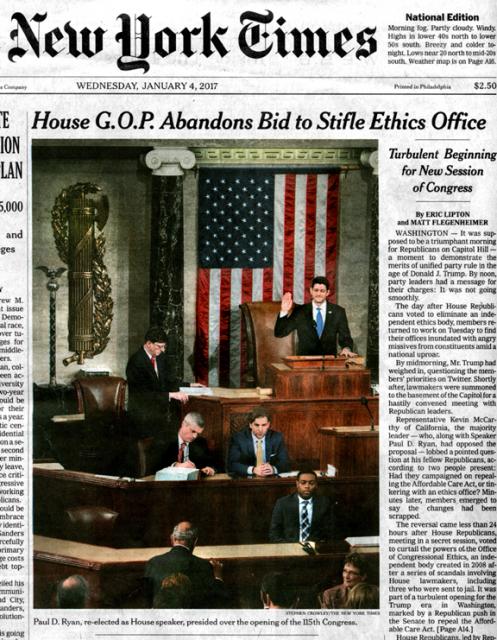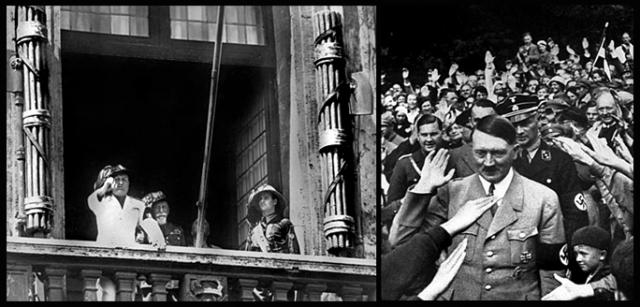Journalism’s role is to comfort the afflicted and afflict the comfortable.
Journalist Finley Peter Dunne (as bartender Mr. Dooley) ca 1900
It’s no secret Donald Trump hates The New York Times. “It’s one of the most dishonest media outlets I’ve ever seen in my life. The worst. The absolute worst!” he said. It’s probably his greatest nemesis, given it’s America’s flagship newspaper and is doing its best to afflict his comfort level as much as possible. The Times is now using the word “lie” in headlines and stories to refer to Trump pronouncements.
The true horror of the moment may reside in the notion the next four years are as much a mystery to Donald Trump as they are to most Americans and citizens of the world. Uncertainty, provocation and chaos are the tools of his dark genius. For better or worse, the nation is adjusting to politics as an unfolding reality drama with aspects reminiscent of the old days of MAD, or Mutual Assured Destruction, when it was national policy to have your opponent uncertain you were not crazy.
As the central player in a multi-billion-dollar political telenovela production called Washington DC: Making America Great Again, the last thing Mr. Trump wants is a crack team of dirty-fingernail, print investigative journalists who think they’re saving the nation poking around in his trash or among his friends and enemies. Times reporters don’t seem to understand that they have been reduced to the level of political opponents. How does a reality star make them behave? He must diminish their character as loathsome, dishonest and immoral seducers or whores. He must punish them by cutting their access to his inner circle. When he can, he will turn a thuggish fan element against the press. Maybe at some point some heads will be broken, or at least he’ll put the notion in their minds. Truth is an antidote to Power, but to be effective, like a pill for some ailment, it must be taken and digested. Convince people the pill is useless, tastes terrible and even has dangerous side effects and power trumps truth every time. Fluoride was a communist plot.
Trump has suggested he might use his and others’ vast resources to bring journalism to its knees with burdensome lawsuits aimed at softening libel laws. At a press conference he dis’ed CNN for first running the rumor (it wasn’t quite a story) that there might be some dirt to be revealed about Trump and Russian hookers. Either because it wasn’t true or because it was true, Trump got angry. The CNN reporter was shut down. With a right wing Supreme Court it’s not beyond the realm of possibility that the right could do damage to the current libel laws. Doing things like injecting the idea of privacy into the libel mix, they might turn libel laws into the legal equivalent of electrified fencing and security around a gated estate. The key case on libel since the 1960s has been Sullivan versus The New York Times, which enshrined the principle that you can’t libel a “public figure.” Who knows where Trump-influenced rulings on Libel Law might stray?
The New York Times looks at Trump as a toxic force that require new rules for journalism. As someone pointed out, there are now three parties in Washington DC. There’s the Republicans and the Democrats — and there’s the Trump Party, with all its disgruntled white, rural working class elements reminiscent of the Know Nothing Party of yore. In this sense, Donald Trump did something no one else has been able to do in modern times: He was elected president as a third-party candidate. Now the Trump Party is in the White House with tendrils reaching into the racist, White Nationalist Movement and tendrils reaching into the the great storehouses of capital in America and the world. Analysts of fascism talk about a pincer arrangement that includes working class thuggery as one pincer and elite-class capital as the other, with the middle class caught in the pincers. Congressional Republicans are said to be “eating toad” to conform with the Trump Party line, as the Trump Party conforms with established Republican programs. This isn’t a pretty picture. Think a fat-cat party of confirmed liars and bullshitters conforming to the rule of an impulsive authoritarian president sympathetic to white nationalist thuggery.
 Saluting Ryan and a Classic Fasces, The New York Times, January 4, 2017
Saluting Ryan and a Classic Fasces, The New York Times, January 4, 2017
In this light, did The New York Times in a front-page picture manifest a modest flip of the bird to this right wing pincer regime taking over power in Washington DC? Was the photograph on the front page of the January 4th Times the case of a well-composed image reporting a real-time vote in the House of Representatives. Or was it a more abstract, more provocative image pregnant with semiotic baggage relevant to the moment?
As a photographer who has read a lot on composition, timing and issues of meaning inherent in the content of a photographic image, the more I looked at the image of Rep. Paul Ryan swearing in the 115th Congress on the January 4th front page, I didn’t know whether to laugh or cringe. The photo by Stephen Crowley accompanied a top-of-the-fold story about a House effort to eliminate under the cover of darkness an ethics oversight body. The action truly smelled and was immediately widely condemned; when Donald Trump learned of it he Tweeted against it, suggesting it was terrible timing. It was quickly taken off the docket and the House chamber was fumigated. The photograph, however, may have a much longer shelf life.
Two things stand out in the image. First, there’s the beautiful fasces in the upper left, the twin of a second fasces on the other side of the speaker’s podium. Based on writings of the Roman epic poet Livius Andronicus, the fasces is described by a website on Italian fascism as “a bundle of white birch rods tied together with a red ribbon. The Fasces represents ‘strength through unity’ – since rods bundled together possess more strength than one individual rod. The axe represents the power of the state to punish the people. Many populist movements in Italy, ranging from socialist to nationalist, used the symbol of fasces for their movements, but the symbol is now recognized almost entirely for the Fascist political ideology of Benito Mussolini.” The former journalist Mussolini coined the term fascism from the Roman fasces, which was employed by magistrates in grand processionals that often included war booty, exotic animals and captured slaves.
So there they are: Two quite large and beautifully rendered bronze fasces on the wall behind the speaker’s podium of the US House of Representatives on the opening day of the new Congress, the same day a gang of House Republicans (let’s visualize them in robes in a Roman drama) tried to disembowel the House ethics oversight body. It should be pointed out that the fasces is not of the order of the swastika. It works more as the symbol of a certain type of power arrangement versus a symbol linked to a specific odious regime. It appears frequently in august locations like the US House of Representatives.
What adds dark power to the image is Speaker of the House Paul Ryan’s upraised arm reminiscent of Adolf Hitler’s characteristically throw-away, limp-wristed heil salute. Sure, we know that Ryan was swearing in the new Congress and not giving a “heil Trump!” salute. For a regime that encourages a climate where symbol and emotion trump facts and power trumps truth — my question is: Does the poetic meaning of an image like this trump the real-life fact?
 Benito Mussolini with fasces left and right; and Adolf Hitler giving his famous salute
Benito Mussolini with fasces left and right; and Adolf Hitler giving his famous salute
All photographers know photographs don’t lie. An image taken by a camera through a lens and shutter system is a mechanical fact influenced by the limits of the frame, composition and timing. The “lying” begins when someone looks at the image and projects meaning into it. Captions are generally where the dishonesty of photographs begin; a caption may be partly or entirely false. Photoshop, of course, has called everything into question. Beyond a photographer’s competence, the power of an image like the one of Ryan comes down to the juxtaposition of symbols that add layers of meaning for those sensitive to the symbols. The great French documentary photographer Henri Cartier-Bresson coined the phrase “the decisive moment.” It’s the quality of being a photographer in the right place at the right time to, theoretically, capture an image that sums up an entire event or larger reality. It can become a zen-like, mystical challenge for photographers. What is the true reality of any moment in time? And can it be captured by an un-constructed, un-posed image?
The more you dig into Stephen Crowley’s January 4th image, the more interesting it becomes. I read a sense of pain and/or boredom in the faces of the four House functionaries whose faces we can see. There’s the guy top left who seems to be lining up paperwork ducks for Ryan. Below him at left, a man is writing intently in some very fat legal tome. To his left, a man sits looking a bit sour, as if he’s in some kind of funk. Maybe it’s late and he wants to go home. Or maybe he’s sour because he doesn’t trust journalists and he’s looking at Crowley working his large Canon with its long lens, his motor drive rapidly collects dozens of images in a matter of seconds. The young African American man may be caught in a blink; but, then, his lips are a bit slack, suggesting he may be dozing off. We just don’t know. The camera and lens have not lied; but like drops of color dye in water, when observed, fiction begins to seep into the meaning of the image.
When politics gets as polarized as it is now in the United States, the classic struggle between fascism and socialism insinuates itself into the political uncertainties of the moment. If someone doesn’t see or understand any of this symbolic baggage, does that mean it’s not there? Is it only in the heads of un-American citizens?
1900: Fascism vs. Socialism
One of the great political films is the 1976 epic 1900 from the Italian master Bernardo Bertolucci. The current cut on DVD is five hours and 20 minutes long, which provoked a friend of mine to say, “That’s not a movie; that’s a relationship.” I’ve watched it three times, the first time in 1976, when Bertolucci released a four hour version in the United States. It did very well in Europe, but not in the US. Bertolucci said that was because “there are too many red flags in it.” He means too many angry peasants waving communist red flags accompanied by the International. 1900 followed his controversial Last Tango In Paris. It was the height of the Cold War, and he wanted to make a historical film that mixed up the creative spirits of great Russian masters like Eisenstein and great American masters like John Ford. The conceit of the movie is that on the same day — January 1st 1900 — grandsons are born to an Italian estate’s patron (Burt Lancaster) and to the estate’s chief peasant (Sterling Hayden). These infants eventually turn into Robert DeNiro and Gerard Depardieu. After 320 minutes of Italian history, they appear in a final scene as eternally squabbling right/left contemporaries at age 76.
